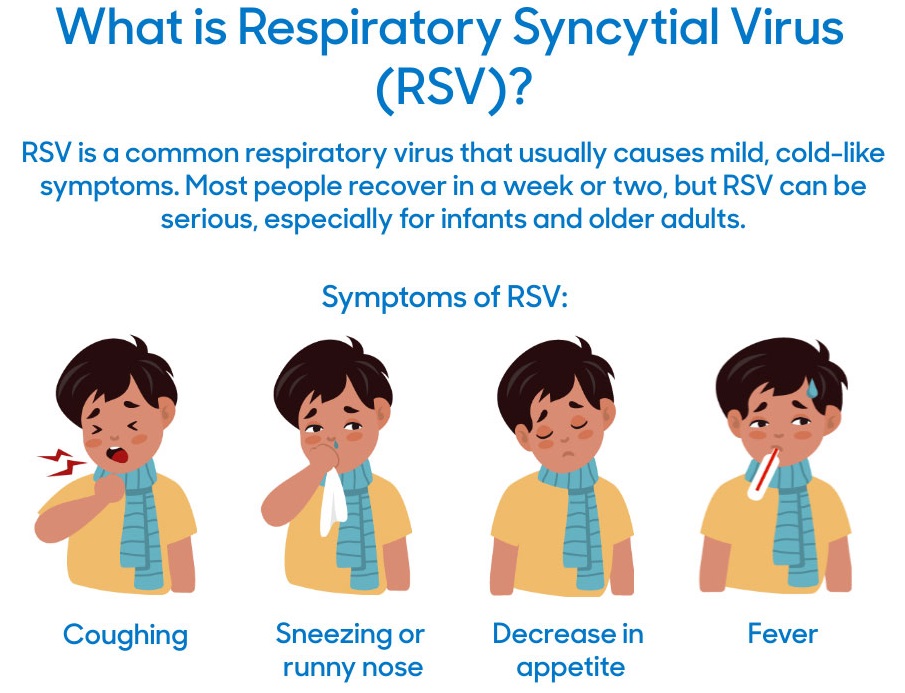What is RSV?
RSV (respiratory syncytial virus) is a common respiratory virus. It targets your lungs, especially small air pathways (bronchioles). RSV is one of the most frequent causes of childhood illness. Most children get the virus by 2 years of age. RSV can also infect adults.
Most healthy children and adults who get RSV will have a mild case with regular cold symptoms. The condition usually resolves itself in about a week.
Premature infants, babies younger than 6 months old, people above age 65 and people who have a compromised immune system, chronic lung disease or congenital heart condition can get a more severe case of RSV. A severe RSV infection can lead to pneumonia and bronchiolitis, which may require hospital care. RSV can also make existing heart and lung conditions worse.
Symptoms
People infected with RSV usually show symptoms within 4 to 6 days after getting infected. Symptoms of RSV infection usually include
*Runny nose
*Decrease in appetite
*Coughing
*Sneezing
*Fever
*Wheezing
These symptoms usually appear in stages and not all at once. In very young infants with RSV, the only symptoms may be irritability, decreased activity, and breathing difficulties.
Transmission & Prevention
RSV can spread when
*An infected person coughs or sneezes
*You get virus droplets from a cough or sneeze in your eyes, nose, or mouth
*You have direct contact with the virus, like kissing the face of a child with RSV
*You touch a surface that has the virus on it, like a doorknob, and then touch your face before washing your hands
People infected with RSV are usually contagious for 3 to 8 days and may become contagious a day or two before they start showing signs of illness. However, some infants, and people with weakened immune systems, can continue to spread the virus even after they stop showing symptoms, for as long as 4 weeks. Children are often exposed to and infected with RSV outside the home, such as in school or childcare centres. They can then transmit the virus to other members of the family.
RSV can survive for many hours on hard surfaces such as tables and crib rails. It typically lives on soft surfaces such as tissues and hands for shorter amounts of time.
People are typically infected with RSV for the first time as an infant or toddler and nearly all children are infected before their second birthday. However, repeat infections may occur throughout life, and people of any age can be infected. Infections in healthy children and adults are generally less severe than among infants and older adults with certain medical conditions.
People at highest risk for severe disease include
*Premature infants
*Young children with congenital (from birth) heart or chronic lung disease
*Young children with compromised (weakened) immune systems due to a medical condition or medical treatment
*Children with neuromuscular disorders
*Adults with compromised immune systems
*Older adults, especially those with underlying heart or lung disease
Prevention:
Preventing RSV can be very difficult, especially because it is spread in droplets of fluid from sneezing, coughing or laughing. Since the virus travels and lives on surfaces.
Steps you can take to try to avoid and prevent RSV include:
* Washing your hands often
*Keeping infants away from children and adults who are exhibiting common cold symptoms can be extremely helpful.
*Avoiding close contact with infected people
*Avoiding second-hand smoke
*Avoiding sharing cups, bottles or toys that may have been contaminated with the virus since the virus can live on surfaces for several hours
How can I tell if my child has COVID-19, RSV or the flu?
COVID-19 has many similarities to the flu and RSV because they are all contagious respiratory viruses that spread from person to person by droplets traveling through the air. But there are key differences as well:
*Children with COVID-19 may not have symptoms at all, or may have a gradual onset of fever, congestion, cough and loss of taste and smell that last anywhere between seven to 28 days. Neither RSV nor the flu typically cause a loss of taste or smell, so if your child has these symptoms there’s a good chance they have COVID-19.
*Older children with RSV usually have minor symptoms similar to a cold. Younger kids and babies with RSV tend to have a slow onset of cold-like symptoms and then a sudden escalation. Symptoms last three to seven days.
*Most children who have the flu will experience a rapid onset of symptoms such as fever, cough and runny nose, and these symptoms will last from five to seven days.
10 things every parent should know about RSV (Respiratory Syncytial Virus)
1. RSV is a major cause of respiratory illness in young babies.
2. RSV is highly contagious.
3. RSV infections often occur during the winter months
5. You can take additional steps to prevent an RSV infection.
6. To prevent serious RSV-related respiratory disease, at-risk infants can be given a monthly injection of a medication consisting of RSV antibodies.
7. Antibiotics aren’t used because RSV is a virus.
8. In healthy kids it’s not necessary to distinguish RSV from a common cold.
9. For most babies and young children, at-home care for RSV is enough.
10. There’s good news! RSV infection is entirely preventable.







